Protein Structure
Proteins
Proteins are the most diverse class of biological molecule. They are composed of long chains of smaller subunits called ‘amino acid’ and proteins can be ‘folded’ into many different structural configurations, resulting in a vast array of possible functions provided to the cell.
Let’s take a closer look now…
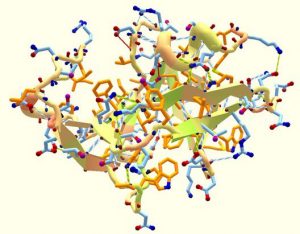
Protein Structure
If we consider that proteins are very long chains of amino acids joined together through a series of peptide bonds, it becomes apparent that the sequence of amino acids will differ between each and every type of protein. It is estimated that there are over 100,000 different types of proteins found in the human body.
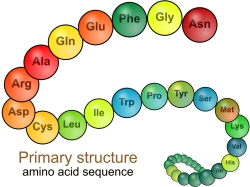
Primary Structure
The sequence of amino acids that occur in a protein, or polypeptide chain, is referred to as its primary structure. This precise sequence of amino acids is determined by the organism’s genetic information, which we will cover in detail later in this course.
Secondary Structure
The different amino acids that make up the primary structure of the protein interact with one another to cause the polypeptide chain to form simple, three-dimensional structures. It is these simple interactions that cause the protein to assume its ‘Secondary Structure’. Examples of secondary structure include a simple helical formation or simple folded sheets.

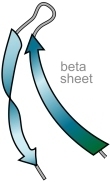
Tertiary Structure
Further folding of the polypeptide chain can occur to form ‘Tertiary Structure’. The Tertiary Structure of a protein can be influenced by the protein’s interaction with water, where the hydrphobic amino acids will orient themselves away from the water molecules and the hydrophilic amino acids will point outward to interact with water. It is the complex tertiary structure of proteins which is essential for their overall function. Heat is a key disruptor of protein tertiary structure and is the main reason protein-rich compounds, such as egg whites, will become altered when heat is applied (think of a boiled or fried egg compared to a raw egg…!)
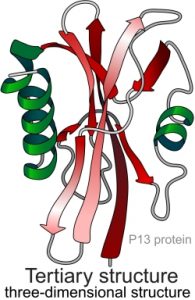
Quarternary Structure
Finally, folded proteins which have assumed their tertiary structure can actually combine together to form larger protein molecules or enzymes. When these multiple polypeptide chains are associated with one another, the protein assumes a ‘Quarternary Structure’ as shown below.
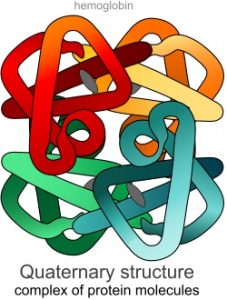
It is important to note that not all proteins have a quarternary structure, but there are some very important ones that do. For example, the protein Hemoglobin consists of four individual polypeptide chains held together through a series of weaker bonds. Each of the four polypeptides in the hemoglobin molecule is capable of binding to iron-containing molecules which carry oxygen throughout the body.
Protein Structure & Function
If we consider that proteins are very long chains of amino acids joined together through a series of peptide bonds, it becomes apparent that the sequence of amino acids will differ between each and every type of protein. It is estimated that there are over 100,000 different types of proteins found in the human body.
Biomolecule Structure
In the activity below, drag the appropriate biomolecule label on the right to label each structure correctly. When all labels have been placed correctly, you will be notified. To reset the activity, click the ‘reset’ button. (Note: you will see this activity several times as you work through this module; you will be able to practice as many times as necessary until you get all of the labels placed correctly)
From http://www.ontrack-media.net/biology/bm1l1drag2.html
Summary
Proteins are comprised of a string of amino acids, all bonded together through a series of peptide bonds (primary structure). Proteins can be folded up to achieve unique 3-dimensional shapes (secondary, tertiary structure) and even interact together to form larger molecules (quarternary structure).
There is a critical link between protein structure and function; in fact, it is the actual amino acid sequence (primary structure) along with the environment which determines a protein’s overall 3-dimensional shape. It is this overall shape of the protein which then provides and determines the function of any given protein.
Proteins play a variety of roles in biological systems, ranging from structural functions to complex movements and chemical reactions (e.g. performed by enzymes).